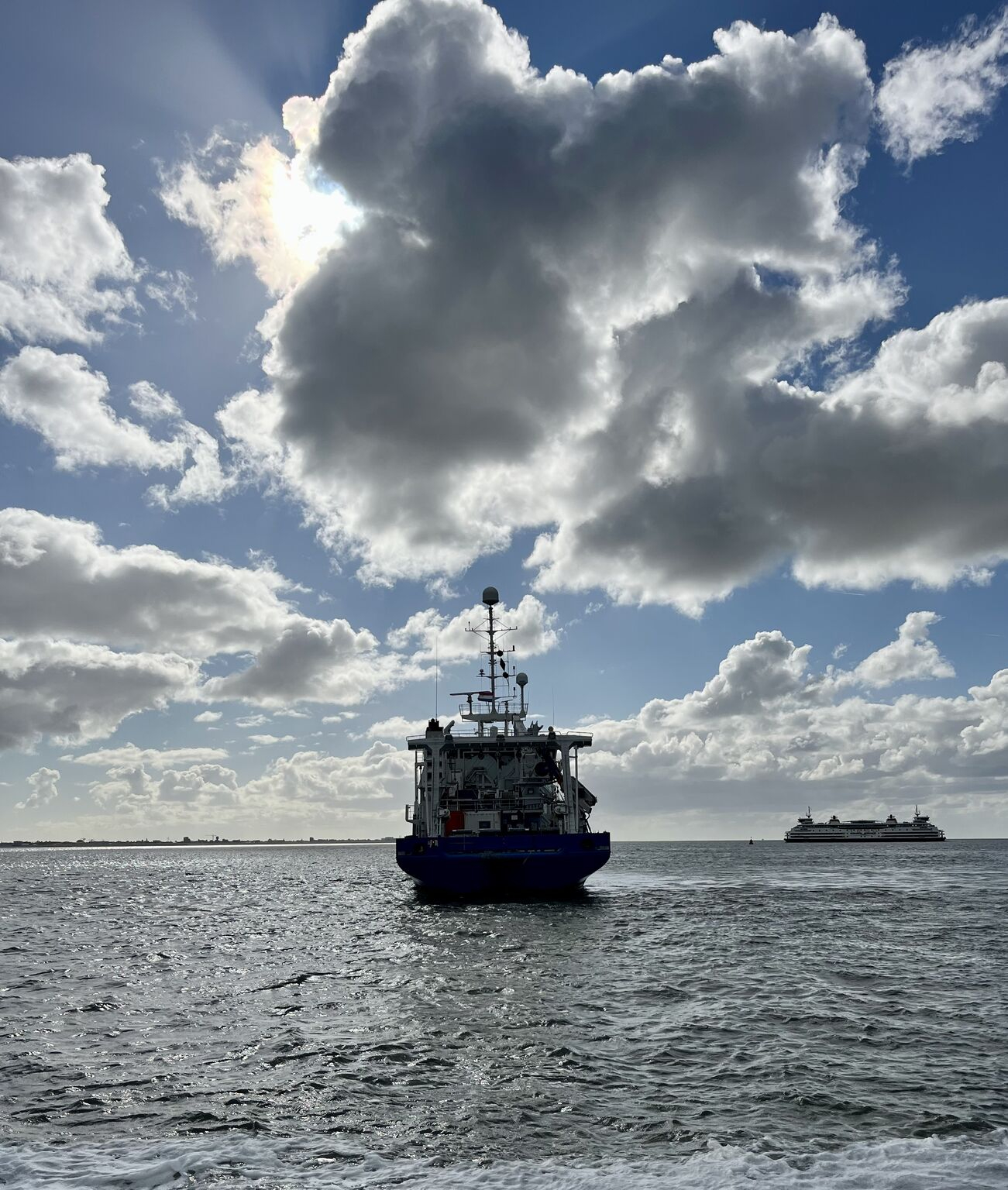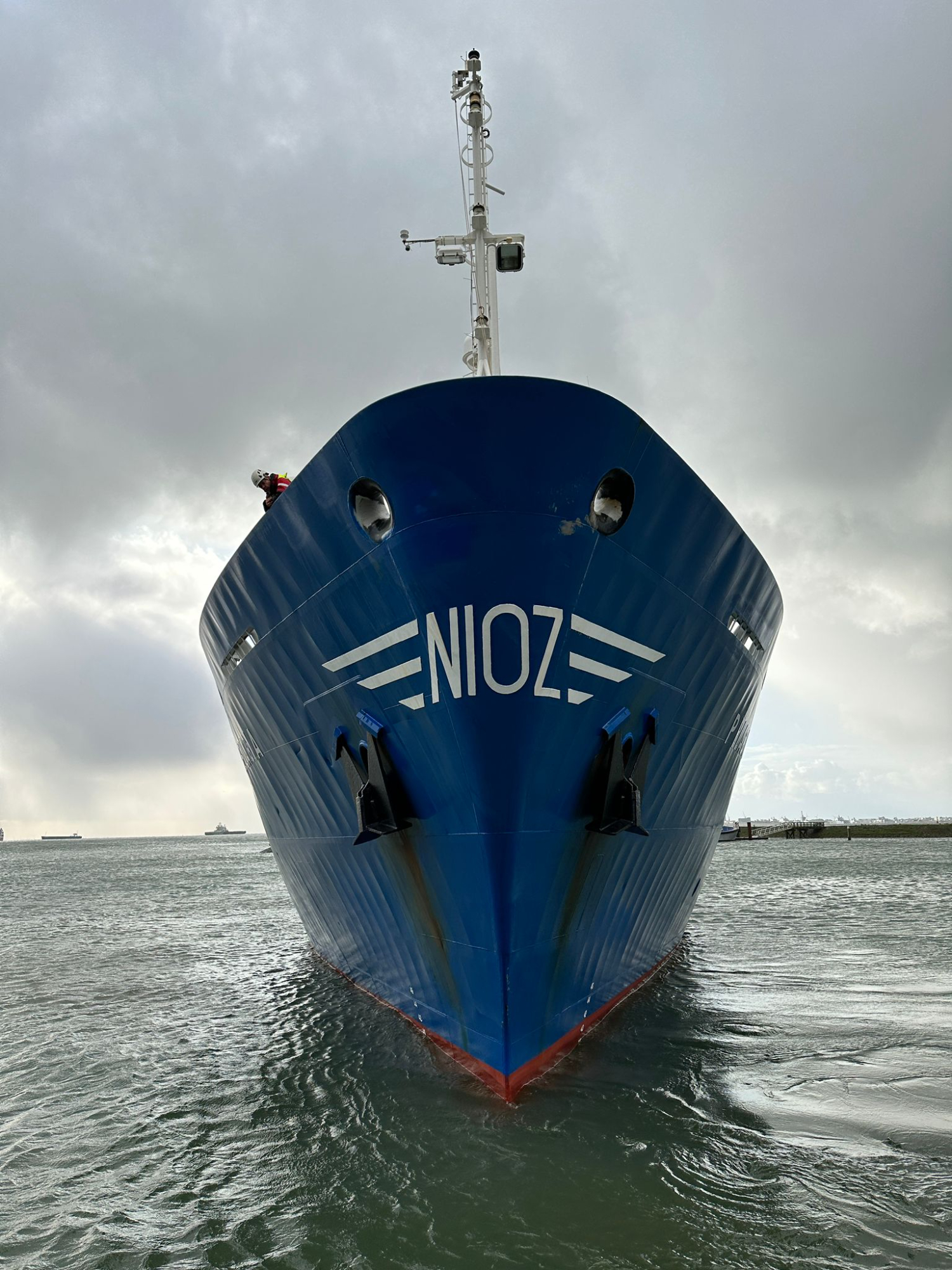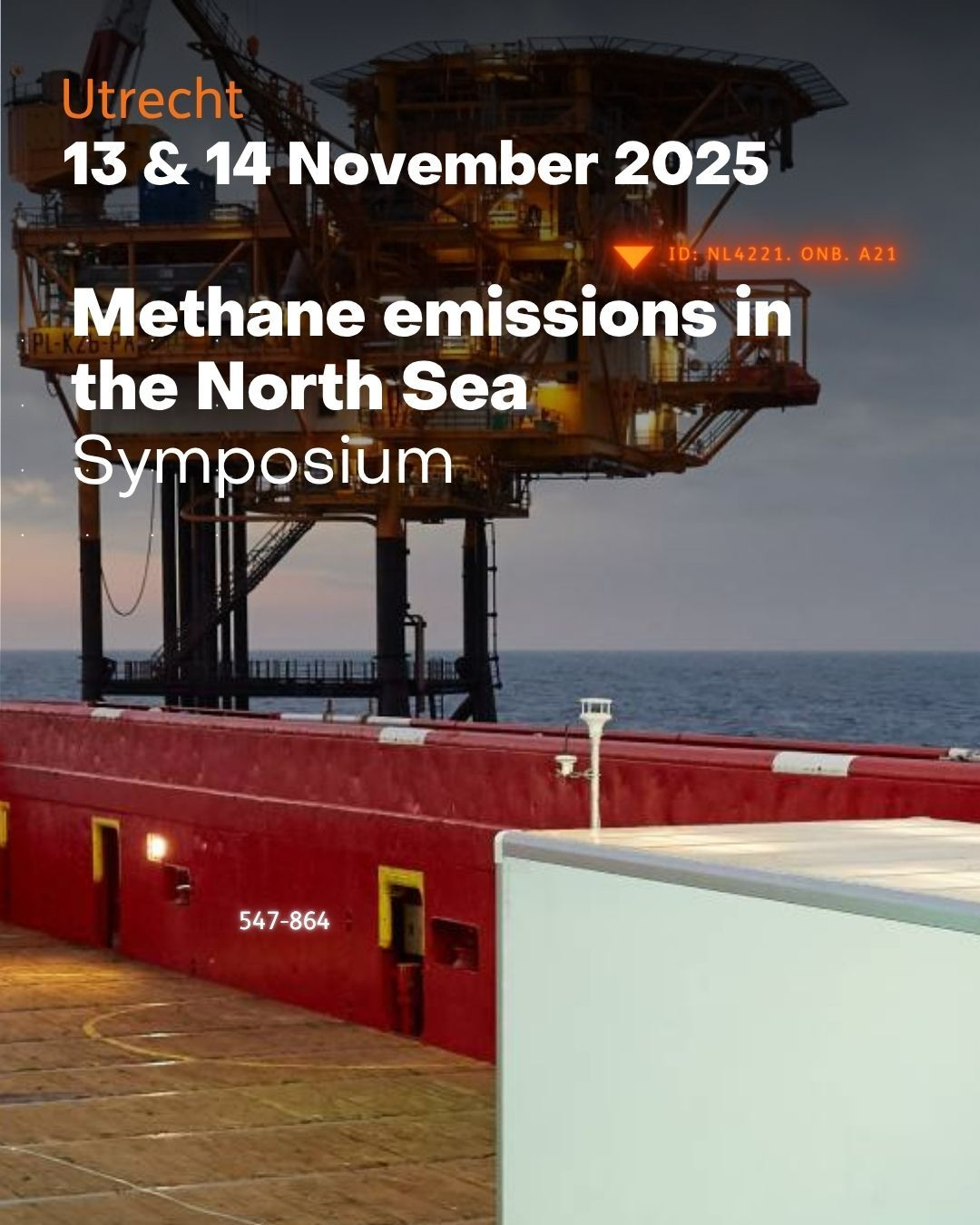Drone images of RV Pelagia on a calm September day on the North Sea (by Maarten Stenneberg)
29 September 2025
Written by Helge Niemann
The first days of our expedition have passed in a blur aboard the RV Pelagia. For the next two weeks, she is our home while we work in the North Sea. We are not the first science crew - far from it. For more than 30 years Pelagia has been the flagship of the Dutch research fleet, carrying countless scientists and being central to many discoveries and breakthroughs.
But this is her final voyage.
We started with a few technical headaches. Winches, hydraulics, instruments meant to measure autonomously at the seafloor - things did not always go as planned. They never do. An expedition is never just science out of the box, it is also improvisation at sea, in conditions where gear will eventually fail. The ship’s crew and our engineers pulled together, solved the problems, and got us moving again. That is how expeditions work: nothing runs perfectly, and progress depends on teamwork - more than on technology.
Our mission? Energy. Methane, to be precise. Large amounts of methane are buried in deep sediment layers of the North Sea and thousands of platforms exploit this gas. But nothing lasts forever: Once a reservoir is no longer viable, the boreholes are sealed. Yet recent findings suggest some of these old wells leak. This raises concerns, as methane is a potent greenhouse gas. At these abandoned wells, we measure whether they leak, how much methane escapes to the water column, and how much is consumed by microbes before it reaches the atmosphere.
For the coming two weeks, Pelagia will do what she always did best: bring scientists to sea, despite problems, despite weather, and make science happen. She has been my working home on seven expeditions across the Atlantic Ocean. I know her working deck, her labs, her bridge… The ship carries many of my scientific memories and leaving Pelagia behind feels a bit like losing a home.
For me, it is an honour to guide this last expedition of Pelagia as cruise leader. But every ending carries the seed of a beginning. Pelagia’s successor, the RV Anna Weber-van Bosse, is in the final stages of construction and will enter service next spring. I will leave Pelagia with one eye crying and the other laughing: farewell to a ship that carried us well, and forward to a new home at sea.

30 September 2025
Written by Rosanne Huybens (TNO)
The day before we leave for the North Sea again, I see some familiar faces on the Pelagia. The people belonging to the faces are crew members that joined the previous Methane Expedition in 2024. They, and some others that make this last journey possible, have been a trustworthy crew that cared for the ship and the people and science on it. Now that I have been living with them for more than a week in a somewhat confined space, I notice that they are breathing the story of Pelagia. Countless expeditions have taken place in corners of all the world, and the stories are there to match. You will not quickly meet a sailor that won’t be able to fill a silent moment - whether all stories are true down to the last word? Perhaps that is up for debate.
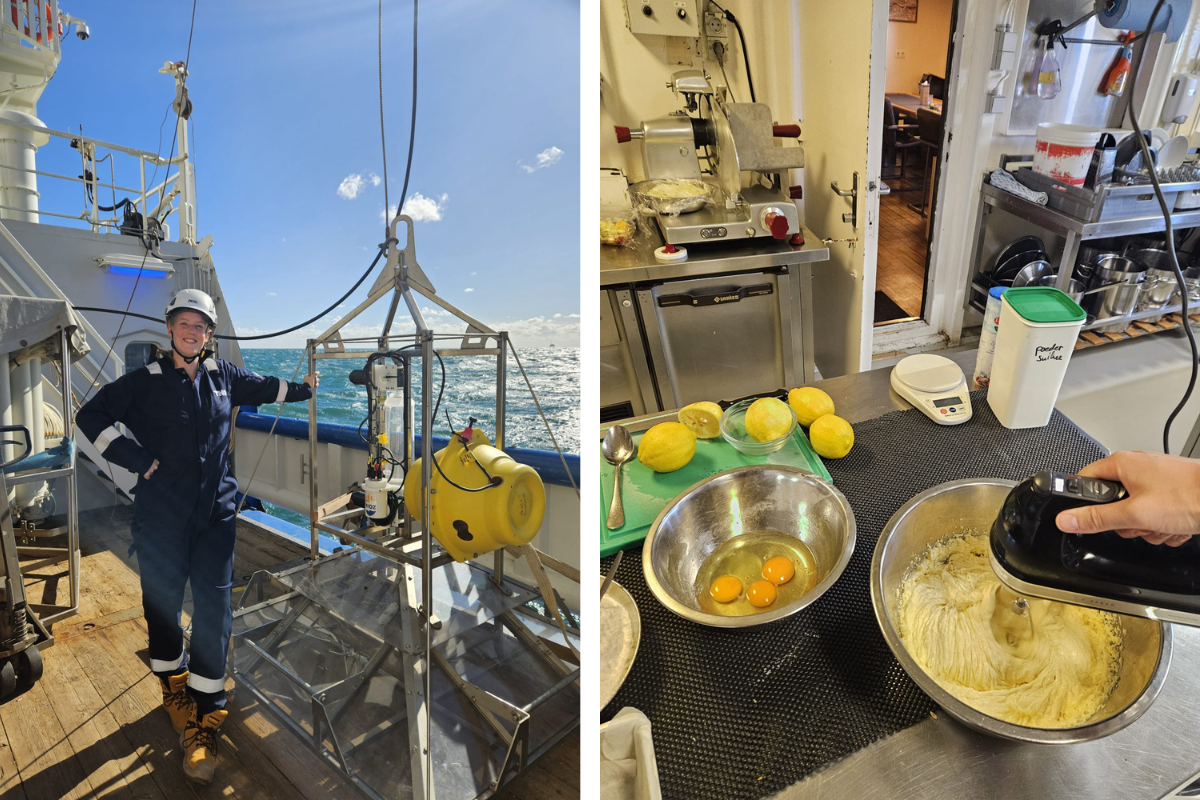
So North Sea again. This time we shift our focus from shallow methane leakage to deep(er) sources. Most ‘conventional’ gas fields in the Dutch North Sea have a depth of roughly three kilometer, and many wells were drilled to explore and produce these fields. Previously, we found that some shallow gas wells were indeed leaking and our quest for this expedition is to investigate if this also applies to deeper gas wells. For Earth’s climate, it would be best if it doesn’t, as there are many more ‘deep’ wells (~2085) compared to ‘shallow’ wells (~55) in the offshore Netherlands. Luckily our Mining Law is very strict, requiring to seal a well when it’s not used anymore - so my hopes are up. Although less bubbles makes for a more boring trip.
Life at sea is different. I know that from last year, but this time I have encountered a new situation where this becomes even more obvious: When you tell the crew that one of your hobbies is baking, you have some free time on your hands, there are two birthdays and have a willing Cook… then you are bound to end up in the kitchen. Rosanne: win, all crew: win, ‘feestvarkens’: win. So, it starts with politely asking if the Cook is willing to share his holy ground with you. Next, you need to plan when you can do the galley-take-over, because you should not be in the way of regular cooking activities. Then, make sure that you have all the ingredients, such as flour, eggs, butter, lemon and poppy seeds. But make sure that there is enough left for next day’s breakfast and also check that no one has a poppy allergy. Work your way through the recipe, using unfamiliar tools and a professional oven. In the end, it is worth it: all people around you indulge in a sweet treat of lemon poppyseed cake. Mission accomplished!
Let’s see how accomplished our mission will be in eight days, after quite some heavy weather that is coming our way.
2 October 2025
By Annalisa Delre
I was originally meant to only join on two cruises, and yet here we are again—back in the North Sea. In autumn - weather-wise not exactly the best season to be at sea! And indeed, the start was far from smooth: delays, malfunctioning instruments, seasickness… but now things are finally running more steadily.
We are looking for leaking decommissioned wells, to measure how much methane is escaping. Our aim is to better understand the origin of the methane - is it from deep or shallow sources? How many wells are leaking? What is the role of methane-eating microbes in removing this greenhouse gas from the water column? These are the questions I have been pursuing since the beginning of my PhD.
It feels strange to think that this is the last cruise with NIOZ, both for me and Pelagia. Over the years, I’ve met so many people on board, from different countries and backgrounds, and I’m grateful that some of them are still part of my life today. Walking through the corridors of NIOZ, I can’t help but smile whenever I run into crew members that I met for the first time onboard Pelagia. How many people have crossed each other’s paths here? From how many countries? Science has this wonderful way of bringing together people from all over the world, united by the same goal.
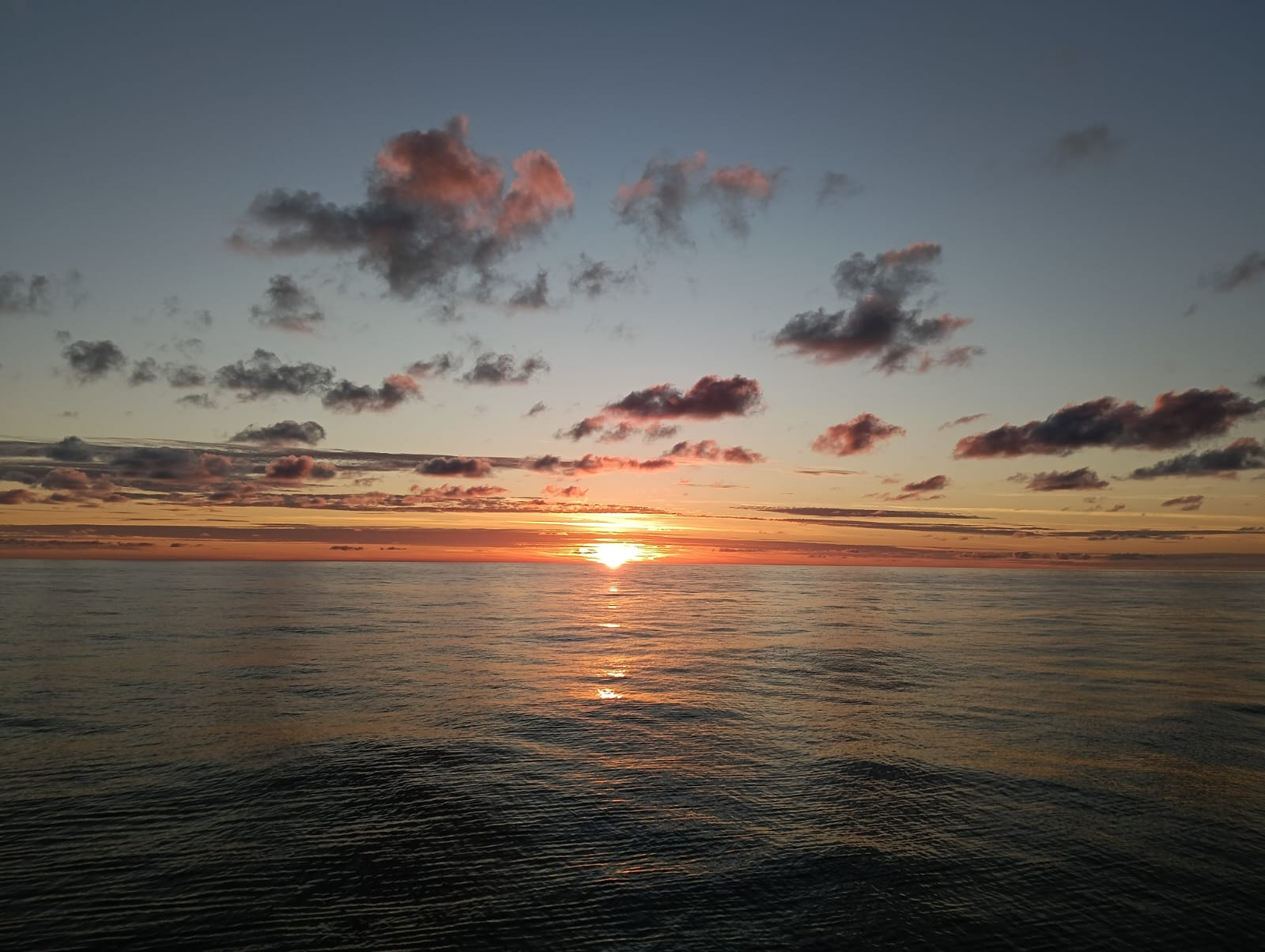
It has been such a great experience, with good and bad weather, with exhaustion and tears from laughing too hard, from frustration, from everything I learned… each of these moments has become a part of my best memories. But just as Pelagia’s story is coming to a close, so too is my PhD project. I hope that soon the results of all these expeditions will find their way into my thesis - the sooner, the better!
For now, though, we’re still taking samples, enjoying the calm weather while it lasts, and making the most of every day. Because - of course - there’s a storm on the horizon.
As with every expedition, I want to thank the crew and everyone else on board for making the work lighter with moments of fun.

3 October 2025
By Martin Wilpshaar (TNO)
Hunting for methane bubbles in the Dutch North Sea
In the summer of 2018 a question of State supervision of Mines (SodM) landed on my TNO desk on alarming publications that leaking abandoned wells in the North Sea were an enormous anthropogenic methane source. I would never have thought that this would bring me seven years later on the “twilight cruise” of the RV Pelagia, the 4th and final expedition of the North Sea Methane Emissions project. The landlubber in me told me that after so many years I should get out of my backseat drivers chair and volunteer for this final expedition hunting for methane bubbles on the Dutch North Sea.
I first learned that the word cruise is a misleading term because for this cruise, you cannot jump onboard without any preparations. So first of all it was necessary to have a medical checkup. I also needed to get a personal safety training. In short this meant besides all kind of theoretical safety instructions, jumping in a large swimming pool wearing a kind of oversized orange Teletubby suit. Furthermore I bought safety shoes and other gear and completed my essentials with some serious reading, “Geology of the Netherlands” the just released nearly 1.000 page thick “bible” for Dutch geologists. Before departure I asked my TNO colleagues, who have been on board before, to tell me their experiences. The keywords I recall from these conversations are 'bucket' and 'gaining weight', which left me a bit puzzled.
Finally at the end of September I arrived at the NIOZ harbour in ‘t Horntje were the Pelagia was waiting for me to join the cruise. I was welcomed by friendly crew members who helped me with my luggage and showed me my cabin. There was some confusion when I mentioned that I brought a “bible”. On my end, there was some confusion due to the upcoming elections—when I was asked which 'party' I supported, a question that seemed to refer to organizations like TNO, SodM, or others rather than political groups. After some technical issues on the Pelagia were solved we finally sailed out to the northern part of the North Sea through some rough sea. This was immediately a test if this landlubber could find his sea legs. Well, I found out that I ordered them with some delay time. When the evacuation exercise was organized during the next morning, I arrived latest at the muster place and sweating all over. What gave me confidence was the sight of the biggest crew member who was standing as a solid rock to welcome. Luckily the weather improved every day and I got more accustomed to the heartbeat of the Pelagia like its regular breakfast, lunch, dinner times and engine sounds. I realized that I was not on a ship but inside the hull of a living creature. I imagined that the crew because of the red overalls are the red blood cells. They take care of delivering the energy and everything more that Pelagia can sail out. The scientific party I am part of chooses the destination and should then (as the “white collar working force”) be the white blood cells running through the Pelagia. Pelagia’s health is very much dependent on the weather: cold weather will reduce blood flow and as such affecting the mood, spirit and atmosphere of everyone working on the Pelagia. So, good weather will do the opposite. With this cruise we were very lucky with a few days of almost tropical windless weather and a flat North Sea. The perfect moment that a BBQ was organized on deck and the moment to get to know “the reds” better. But the moment of good weather was only the calm before storm Humberto, with expected wind force up to 10 Beaufort. This meant that we had to take shelter on Texel and needed to endure again a rough sea. Lucky for me that my sea legs did not leave me during the good weather. We will sail out after the storm to do some extra hunting on methane bubbles on the North Sea.
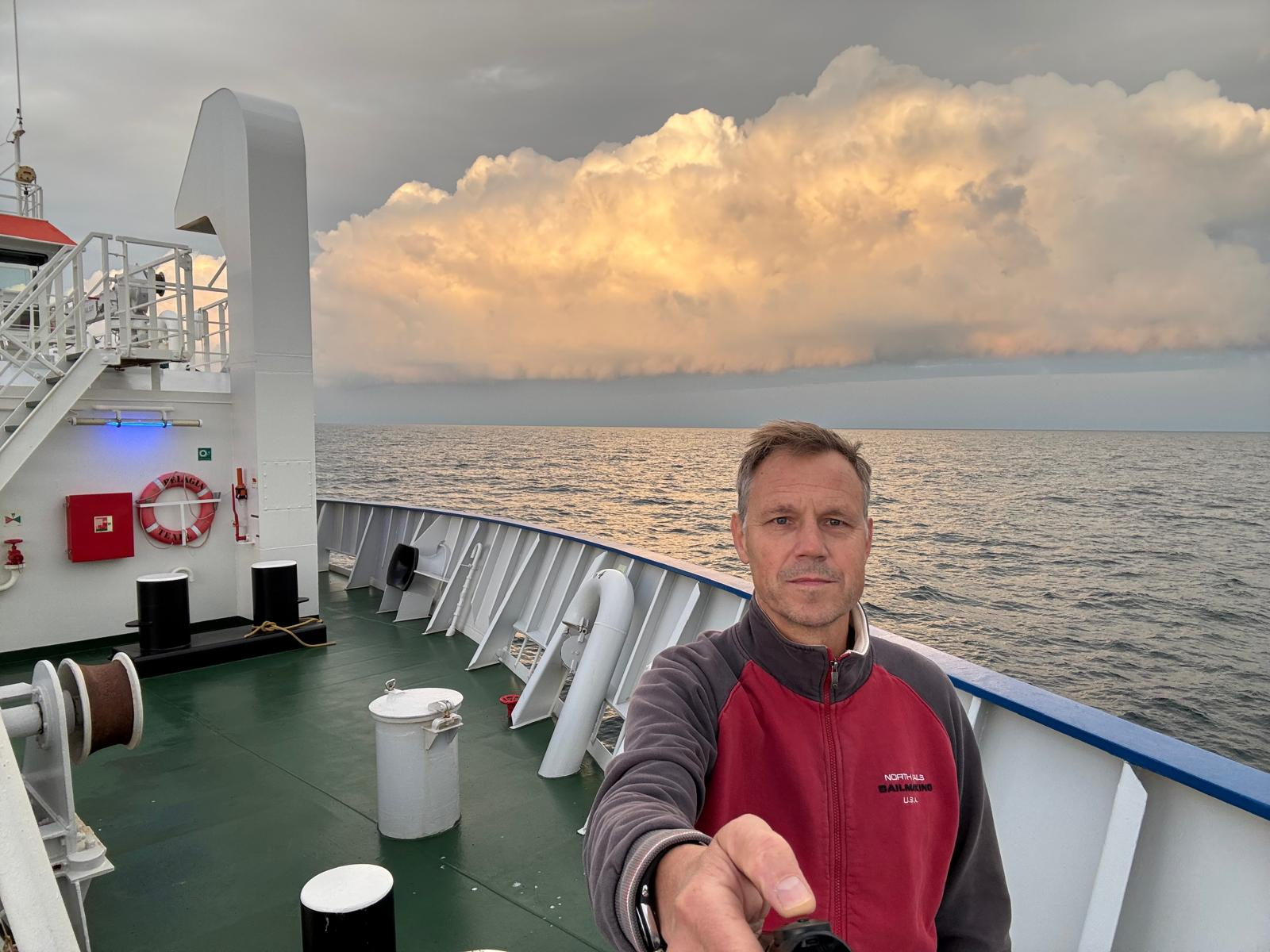
Having been part of this project from the very beginning, I can confidently say it has been, and continues to be a successful collaboration between NIOZ, TNO, and SodM, with promising prospects for the future. TNO’s subsurface expertise complements NIOZ’s knowledge of the seafloor and water column remarkably well. This project has already provided clear evidence that the alarming conclusions presented in the publications which initiated it are not fully applicable to the Dutch part of the North Sea. The “twilight cruise” has given us even more amazing results which we should be credited to the Pelagia in forthcoming publications.
I am very happy to have been part of the “twilight cruise” an experience I will never forget. A big thank you to the crew and the Pelagia. This landlubber will leave the Pelagia knowing that he has a kind of sea legs.
6 October 2025
By Laurens van der Marel (TNO/NIOZ)
From the surface to the seabed; the North-Sea is not new to me, but how I’ve come to know her during the Methane Expedition #4 is nothing short of something special. After working as a hydrographic surveyor for a year, I decided to continue my studies with a Master in Earth Sciences. After some coincidences and opportunities which crossed my path, I think I can convincingly say that I’m extremely lucky to be able to take part in the last cruise of RV Pelagia, not just as a surveyor, but also for my MSc research project. With my thesis, I will be aiming to contribute to the knowledge of how to accurately quantify methane leakage acoustically. This will be done with the help of a multibeam echosounder and an artificial bubble plume generator designed by the NIOZ workshop.
Even though this bubble generator is the smallest of the 3 structures we placed on the seabed during this cruise, it was certainly not without any stress. Adjusting flowrates, capturing bubble sizes and doing funnel measurements below almost 50 meters of water comes with a lot of challenges. How did we overcome those challenges? With a giant underwater machine equipped with four propellers, different kinds of cameras and two hydraulic arms. It definitely leaves an impression to see this Remotely Operated Vehicle (ROV) executing very intricate manoeuvres, despite the harsh conditions below the sea.
Fortunately, it’s not stressful all the time. The combination of scientists and ship’s crew being together for longer time periods gives plenty of room and time to talk about something new and to enjoy the here and now.
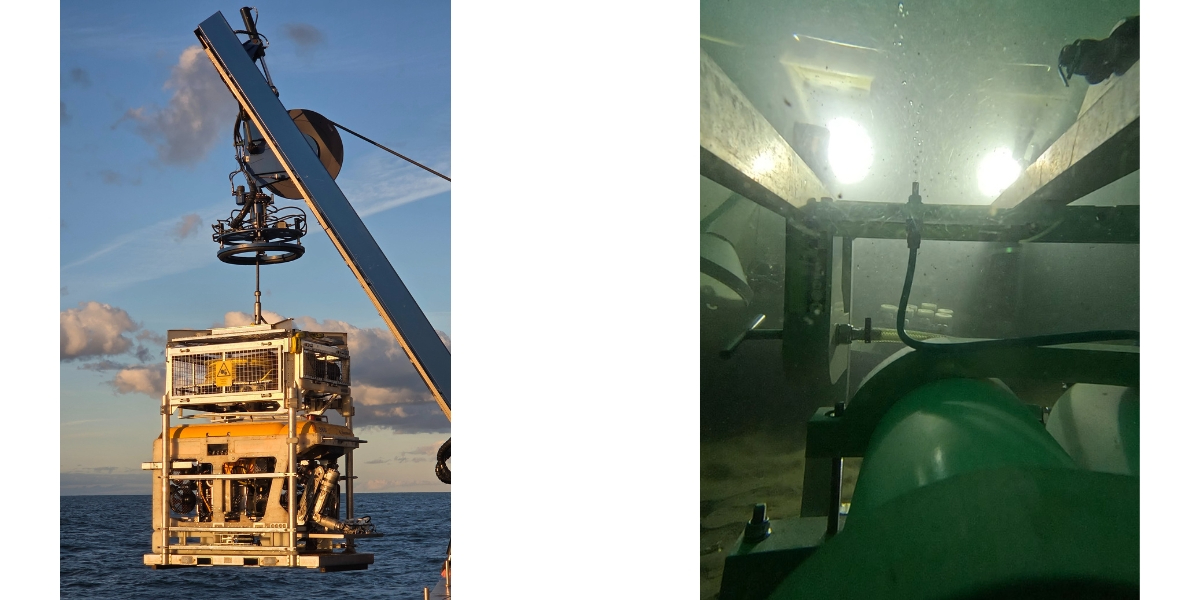
8 October 2025
By Barend van Engelenburg (State Supervision of Mines, SodM)
Aftercare for abandoned wells: measuring is knowing.
In 2020, I became a research coordinator at SodM, having previously worked mainly on underground storage. Fairly quickly, the initiators of the Measuring Methane Emissions in the North Sea project, both within and outside SodM, came to see me at my desk. There was a sense of urgency because stories about leaking wells in the North Sea were receiving a lot of media attention, so it was important that we conducted our own investigation into this matter. As this was a large project in terms of both finances and duration, it was important to prepare it well. This was achieved in collaboration with our partners, NIOZ and TNO, in 2021, with the project commencing in early 2022. I have therefore been involved from the very beginning.
None of the previous voyages suited me, but I wanted to experience this one. I wanted to find out what it meant to take measurements at sea. I also wanted to bring this experience to the symposium that we are organising on this subject on 13 and 14 November (see: https://www.aanmelder.nl/methanesymposium/home).
What was it like to be on board and participate in the measurements? Firstly, I had to make some physical adjustments; I immediately felt the waves in my legs, for example. On the first day of sailing, I certainly got to know the toilet well. But it wasn't as bad as I had expected. Working behind a screen while sailing now comes quite easily to me. That's more or less the worst thing you can do when you're seasick.
Working and taking measurements on board is a good example of teamwork. The 'regular' crew handle the equipment that needs to go into the water very smoothly, responding well to the 'scientific' crew's requests. Of course, some equipment does not work immediately, or as hoped or expected. What struck me most is that everyone is very solution-oriented and flexible. It is good to see and experience that. The expertise of both parts of the crew was evident in many areas.
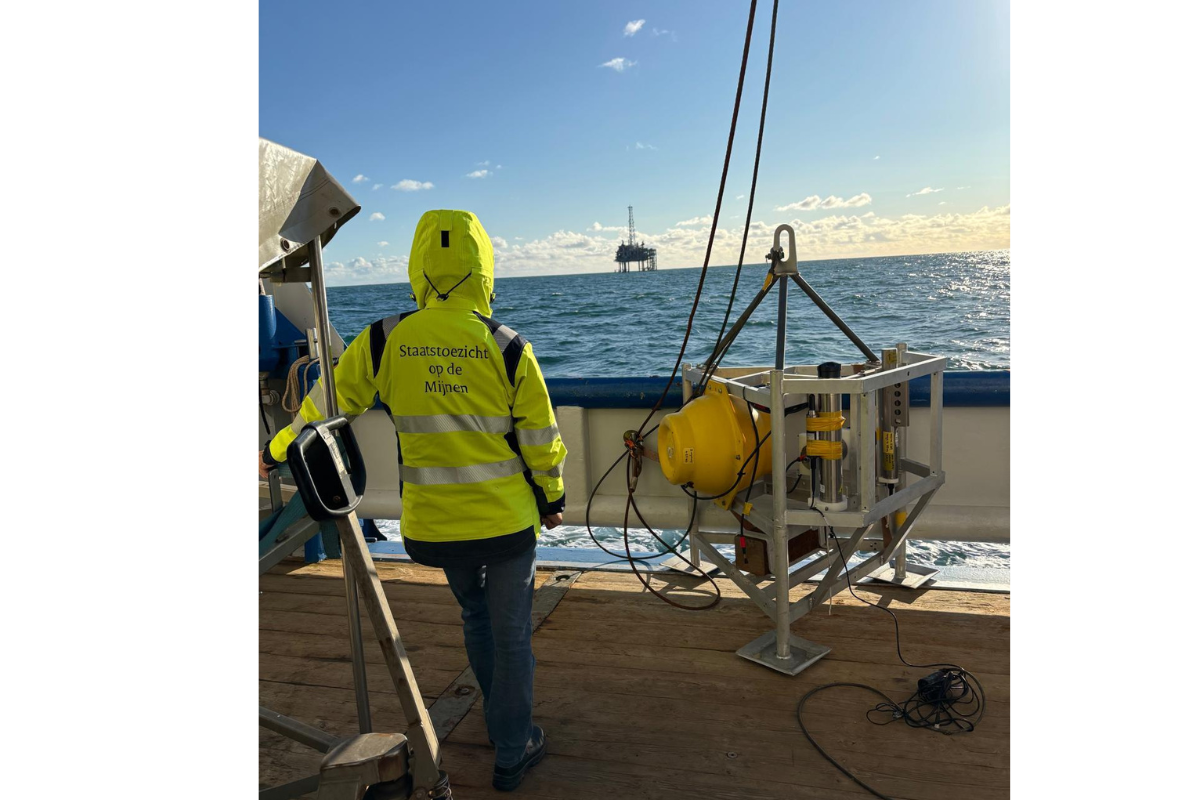
This fourth and final cruise for the research project has again provided valuable new insights. Some of these can be read above in the other blogs, while others will be investigated further and lead to publications. My main takeaway from this trip is that accurate measurements are necessary before making statements about well leaks, and that measurement is not that easy. At the moment, I am less concerned about well leaks on the Dutch Continental Shelf, than I was in 2020. The conclusions of the measurements have not yet been finalised, but I am confident that this project will lead to positive outcomes for the next stage of abandoned well monitoring. I would like to thank the entire crew of the Pelagia's final voyage for the NIOZ for providing me with such a wonderful and special experience.
10 October 2025
Written by Helge Niemann
Back on Land
We are back — the open sea now lies quietly on the other side of the harbour pier. Fifteen days at sea, and two days in port when storm Amy forced us to seek shelter, are behind us. It was an intense period of breathing science 24/7, solving problems of every kind — but in the end, I look back on this cruise with real fondness. One last time with the old dame Pelagia — and she truly delivered.
We sailed about a thousand miles, scanning the water column for methane gas bubbles rising from the seabed at more than eighty stations, collecting water samples, deploying landers, and living on a constantly moving ship. We watched screens as fans of acoustic beams revealed vast areas beneath the vessel, while semi-autonomous probes provided, in real time, glimpses into the North Sea’s interior. We debated new measurements and optimised workflows to make the most of our precious ship time. We stood shoulder to shoulder in the control room to watch video footage from our ROV dives — a remotely operated “submarine drone” that showed the seafloor in stunning detail.
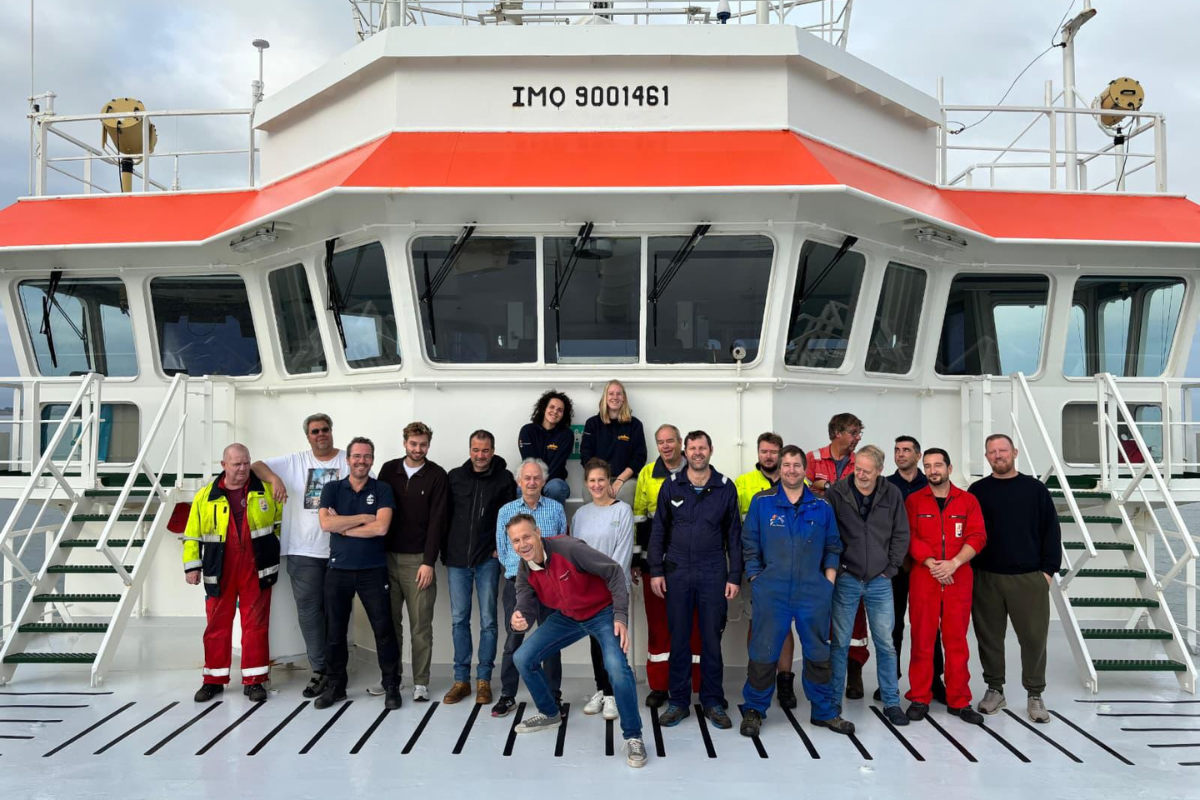
And the science crew? Now we are scattered, but we will meet again — some in person, others remotely. I will already discuss preliminary results with colleagues during a symposium in November (Methane Symposium). Much work still lies ahead: data must be analysed, evaluated, and cross-checked.
For now, however, the expedition is over — at least for the moment. After some proper sleep and time with friends from whom I’ve been separated, I’ll pay my respects to Pelagia once more, when we officially retire her. But in a few weeks, I will visit the new flagship of the Dutch research fleet at the wharf, where the final touches are now being made to the Anna Weber Bosse. In every ending lies the seed of a new beginning
